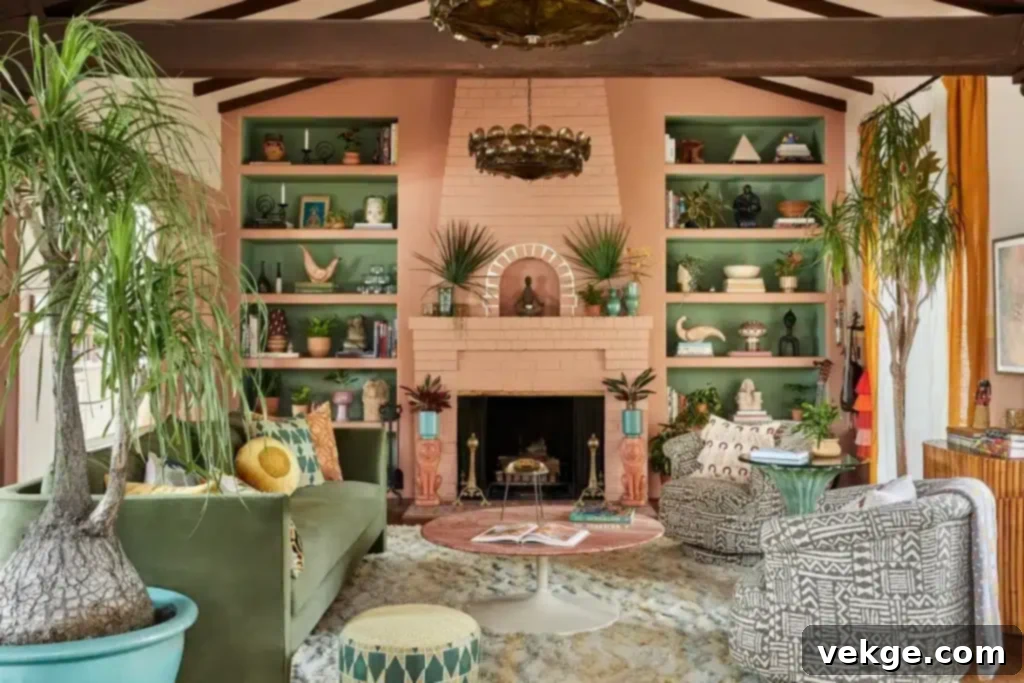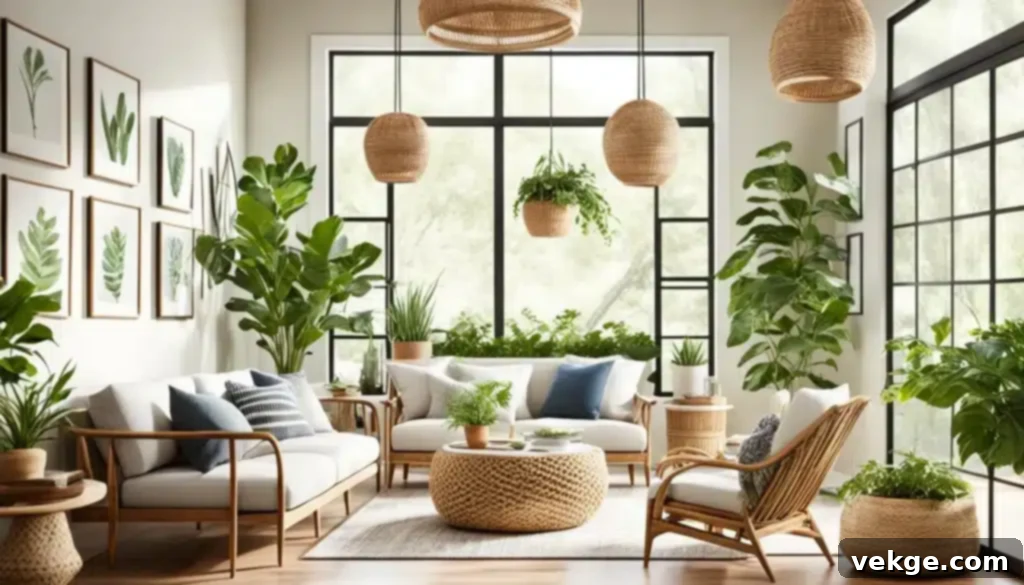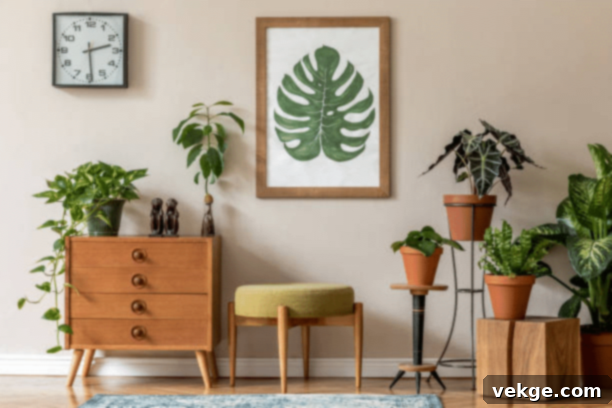Elevate Your Living Space: The Ultimate Guide to Integrating Indoor Plants in Modern Home Design
In the evolving landscape of modern home design, the integration of plants has transcended fleeting trends, establishing itself as a fundamental element that significantly enhances both visual appeal and the overall quality of life for inhabitants. This burgeoning movement, affectionately dubbed “Botanical Bliss” or biophilic design, is fueled by a heightened global consciousness concerning environmental sustainability, a renewed appreciation for nature, and a growing desire to cultivate healthier, more harmonious living spaces.
This comprehensive guide will delve into the profound impact that indoor plants exert on contemporary home aesthetics and functionality. We will explore their diverse contributions, ranging from their undeniable beauty to their tangible health benefits, and furnish you with practical, actionable tips for seamlessly weaving the vibrancy of greenery into every corner of your home, creating an oasis of calm and natural elegance.
The Aesthetic Mastery of Plants in Interior Design

While the concept of bringing plants indoors is rooted in historical practices, their application in modern design has blossomed into an art form, becoming an indispensable tool for interior decorators and homeowners alike. Plants possess a unique ability to infuse any room with a sense of vitality, freshness, and unparalleled serenity. They are far more than mere decorative accessories; they are living sculptures that breathe life into inanimate spaces.
The strategic incorporation of plants introduces a dynamic interplay of color, texture, and form, making them incredibly versatile design elements. A towering Fiddle Leaf Fig (Ficus lyrata), with its bold, sculptural leaves, can command attention as a stunning focal point in a minimalist living room, grounding the space with an organic presence. Conversely, a carefully curated collection of smaller succulents and cacti can lend subtle sophistication and architectural interest to a bright, modern kitchen or a tranquil home office. The choice of plant can profoundly influence the mood and style of a room, whether aiming for a lush, tropical vibe or a sparse, contemporary feel.
Moreover, the inherent flexibility of plant arrangements allows for endless personalization and creative expression in home decor. Hanging planters, suspended from ceilings or wall-mounted, can introduce vertical interest and depth to an otherwise monotonous wall, drawing the eye upwards and making rooms feel more expansive. Intricate terrariums, miniature self-contained ecosystems, offer a whimsical and captivating touch to bookshelves, desk spaces, or coffee tables, inviting closer inspection and adding a touch of natural wonder. For residents in bustling urban environments where floor space is a premium, vertical gardens or living walls provide an ingenious solution, allowing for a substantial integration of nature without sacrificing precious real estate. These green installations not only optimize space but also serve as breathtaking living art pieces.
The Profound Functional Benefits of Interior Greenery

Beyond their undeniable aesthetic charm, indoor plants play a crucial, often underestimated, role in enhancing the overall quality and health of our living environments. They are nature’s silent air purifiers, diligently working to cleanse the air we breathe. Numerous studies, most notably pioneering research by NASA, have conclusively demonstrated plants’ remarkable ability to absorb harmful volatile organic compounds (VOCs) such as formaldehyde, benzene, trichloroethylene, and xylene from indoor air. NASA’s Clean Air Study famously concluded that certain houseplants can remove up to 87% of air toxins in just 24 hours. This natural detoxification process contributes significantly to creating a healthier home atmosphere, potentially mitigating the incidence of respiratory issues, allergies, and other health problems linked to indoor air pollution.
Furthermore, the presence of plants profoundly contributes to our psychological well-being. This phenomenon is often attributed to the “biophilia hypothesis,” which posits that humans have an innate tendency to connect with nature and other living systems. Scientific research consistently shows that interacting with or simply being in the vicinity of plants can significantly reduce stress levels, alleviate symptoms of anxiety and depression, and foster a greater sense of calm and contentment. Green spaces have been linked to increased creativity, improved concentration, and enhanced mood. The soothing visual presence of greenery, combined with the subtle release of oxygen and moisture, creates a restorative and tranquil sanctuary, making homes ideal settings for relaxation, focused work, and joyful living.
The act of caring for plants itself offers therapeutic benefits. Nurturing a living organism provides a sense of purpose, accomplishment, and a tangible connection to the natural world. This daily ritual can be a meditative practice, encouraging mindfulness and providing a welcome respite from the demands of modern life. Beyond air purification and mental health, plants can also contribute to regulating indoor humidity levels, especially beneficial in drier climates, and even act as natural sound dampeners, subtly absorbing ambient noise and contributing to a more peaceful home environment.
Incorporating Plants into Home Design: Practical & SEO-Friendly Tips
Integrating plants seamlessly into your home design requires a thoughtful approach. Here are expanded tips to help you cultivate your personal indoor jungle:
- Choosing the Right Plants for Your Space: The first step is to assess your home’s unique conditions. Consider factors like available natural light (direct, indirect, low light), humidity levels, temperature fluctuations, and your personal commitment to maintenance. For dimly lit areas, robust species such as the Snake Plant (Sansevieria trifasciata), ZZ Plant (Zamioculcas zamiifolia), or Philodendron are ideal choices, thriving with minimal light. Sunny windowsills, conversely, are perfect habitats for light-loving succulents, cacti, and the vibrant Geranium. Always research specific plant needs before purchasing. Remember to also consider pet-friendly options if you have furry companions.
- Creative Placement for Visual Impact: Think beyond traditional potted plants on the floor. Utilize unusual and unexpected areas to add visual intrigue and maximize space. Consider elegant hanging planters suspended from the ceiling to create a cascading effect or wall-mounted planters that act as living art pieces. Built-in plant boxes in windowsills not only maximize natural light exposure for your plants but also create a charming, integrated design element. Plant stands of varying heights can create interesting layers, while terrariums can bring a micro-landscape to a desk or shelf. Don’t forget bathrooms – many plants, like ferns and orchids, thrive in the humid conditions, transforming a functional space into a spa-like retreat. Visit this resource for more innovative ideas on plant integration.
- Mastering Scale and Proportion: Achieving balance in plant placement is crucial for a harmonious design. Pay close attention to the size of your plants in relation to the room and furniture. Larger, statement plants like a Monstera Deliciosa or an indoor tree are best suited for spacious rooms where they can truly shine without overwhelming the area. In smaller rooms, a single large plant can feel dominant, while a collection of smaller plants, thoughtfully grouped, can enliven a compact area without making it feel cluttered. Consider the mature size of the plant when making your selection to avoid future overcrowding.
- Selecting Complementary Containers: The pots and planters you choose are just as important as the plants themselves, acting as an extension of your home’s design aesthetic. Explore a variety of materials: sleek ceramic for a modern look, rustic terracotta for a bohemian vibe, polished metal for industrial chic, or woven baskets for natural warmth. Colors and textures should harmonize with your existing decor style, whether you opt for contrasting hues to make a statement or subtle tones for seamless integration. Don’t shy away from upcycling unique items like old teacups or vintage crates into charming planters. For inspiration on finding unique decor elements, you might find this site useful.
- Grouping Plants for Dynamic Displays: Instead of scattering individual plants, consider grouping several plants together. This creates a more impactful visual statement and also helps to create a microclimate that benefits the plants, increasing humidity. Vary plant heights, leaf shapes, and textures within a grouping for a lush, layered effect. A collection of small, diverse succulents on a tray or a cluster of leafy plants of different sizes in a corner can create a stunning focal point.
- Embracing Seasonal Changes and Plant Rotation: To keep your interior design fresh and vibrant throughout the year, consider rotating or swapping out certain plants according to the seasons. This allows you to introduce new colors, forms, and adapt to changing light conditions. For example, sun-loving plants can be brought to brighter windows in winter, while shade-tolerant varieties can take their place during sunnier months. This dynamic approach ensures your home always feels alive and responsive to nature’s rhythms.
Challenges and Key Considerations for Plant Enthusiasts
While the benefits of integrating plants into home design are abundant, it’s essential to acknowledge and prepare for certain challenges. The most significant consideration is proper plant care, which requires a time commitment and a basic understanding of horticulture. Factors such as inconsistent watering (both over and under-watering are common culprits), inadequate light exposure, or pest infestations (like spider mites or mealybugs) can severely impact a plant’s health. It is paramount to educate oneself on the specific care requirements of each plant type, including watering schedules, light preferences, soil needs, and feeding routines. Establishing a routine and observing your plants regularly can prevent most issues.
Furthermore, considerations for household members are vital. Individuals with allergies or asthma may need to select hypoallergenic plants that produce minimal or no airborne pollen. Examples include succulents, orchids, or Dracaena species. Pet owners and families with young children must also be vigilant about choosing non-toxic plant varieties, as many common houseplants can be harmful if ingested. Always research plant toxicity levels and keep potentially harmful plants out of reach. Consulting with a local botanist, a knowledgeable nursery professional, or an online plant safety database can provide invaluable guidance on selecting the safest and most suitable plants for your specific home environment and lifestyle.
Conclusion: Cultivating a Greener, Healthier Home
The burgeoning trend of incorporating plants into modern home design is more than a fleeting fad; it reflects a profound societal shift towards sustainable living, mindful well-being, and a deeper connection with the natural world through biophilic principles. Plants offer an unparalleled array of benefits, from significantly enhancing the aesthetic appeal and visual richness of our homes to dramatically improving indoor air quality and fostering robust psychological health.
By thoughtfully integrating greenery, contemporary home design can achieve a delicate and powerful balance between beauty and functionality, crafting spaces that are not only visually captivating but also intrinsically health-promoting and spiritually enriching. Embracing “Botanical Bliss” allows us to bridge the gap between our indoor sanctuaries and the vital outdoor environment, inviting nature’s restorative powers directly into our everyday living spaces. This conscious effort transforms houses into vibrant, breathing homes that nurture the soul and invigorate the senses, paving the way for a greener, healthier future of interior living.
